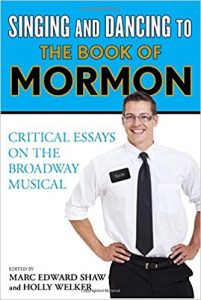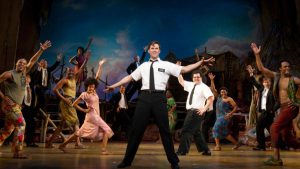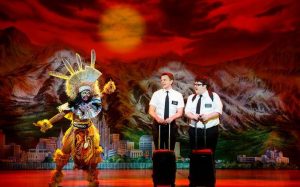Introducing Singing and Dancing to the Book of Mormon: Critical Essays on the Broadway Musical
by Jerry Argetsinger
 Singing and Dancing to the Book of Mormon: Critical Essays on the Broadway Musical
Singing and Dancing to the Book of Mormon: Critical Essays on the Broadway Musical
Edited by Marc E. Shaw & Holly Welker
Roman & Littlefield Publishers, 2016
Hardcover, 196 pages, $75.00 (Kindle $56.80)
Now in its 7th year, having opened March 24, 2011, Trey Parker, Robert Lopez and Matt Stone’s The Book of Mormon is still one of the most popular shows on Broadway. Two national tours have been crisscrossing North America for five years. Productions are also running in London, since 2013 and Melbourne, since earlier this year. Even as I write, a National Tour is performing for the second time in Salt Lake City.
An excellent collection of critical essays on the musical was published last year but seems to have gone mostly unnoticed. Mark E. Shaw and Holly Welker’s Singing and Dancing to the Book of Mormon: Critical Essays on the Broadway Musical has yet to be reviewed in any theater or academic venue. I was invited to write a brief introduction to the book for AML, even though I authored one of those essays. To be completely transparent, I do not know any of the other contributors and the first time I read their essays was when I received my author copy of the book May 3, 2016. When I finished reading the volume, I wrote this general response in my journal: “Six brilliant, two very good, and two all right essays on the Musical.” Of course I included my own as one of the six, so there may be a bit of exaggeration on that point. I was honestly amazed at the quality of scholarship and am very proud to be included. Among the “reader reviews” at Amazon.com and Mormon Main Street, it is clear that essays are valued differently by individual readers who point out their own favorites.
Shaw and Welker introduce the collection with “How Understanding The Book of Mormon Makes the Peculiar Possible” in which they present their thesis:
But it’s not surprising that the South Park guys arrive at all sorts of insights about Mormons and that their portraits of Mormons and Mormonism are faithful and emotionally accurate as opposed to faith-promoting and proper (which is what the leaders in Salt Lake City would prefer). Mormons so often want to tell a particular story about what it feels like for us to be Mormons, while The Book of Mormon tries to tell a universal coming-of-age story about what community, faith and the loss of both feel like, via Mormons. (p. xx)

The collection is divided into four parts, the first of which is “The Genesis of The Book of Mormon.” Stephanie Lim kicks things off by establishing a theoretical justification for works that use the profane to accomplish noble ends, “Good Intentions and (Un)Acceptable Laughter: How the Carnival Inverts Cross-Cultural Relationships in The Book of Mormon.” She describes how Russian philosopher Mikhail Bakhtin’s thesis of “Rabelaisian carnival” where an explicit rebellion against the social hierarchies and system of values is turned upside down in order to achieve renewal can be used to examine the “spirit of rebellion and renewal” in the musical. Gerald S. Argetsinger’s “The Book of Mormon Musical and the Cumorah Experience” examines how the musical creative teams’ visit to the Hill Cumorah Pageant and LDS historic sites around Palmyra, NY (July, 2009) impacted the overall development of the musical’s script. It includes a point by point comparison of both the pageant and musical’s scripts, the team’s personal response to their experience, and the continued impact of the Cumorah experience as two National Tour casts visited the Palmyra historic sites in 2013 and again in 2014. “A Mormon Just Believes” And So Do Lots of Other People” by Ryan T. Cragun concludes this section with an analysis of how Parker and Stone’s trademark creative objective of religious mockery is actually pro-belief, “beliefs that inspire a sense of solidarity with all humans and motivate people to help others.” (p. 29) He demonstrate how a substitute for organized religion is proposed, that of a kind of spirituality that brings all humans together.
Part 2 of the volume, “Theology, Ethics, and Creativity in The Book of Mormon” offers two essays: “Reinhold Niebuhr and Religious Foolishness: “A Mormon Just Believes” by Roberto Sirvent and Neil Baker, and “Faith in Fiction: Creative Practice and the Persistence of Doubt” by Jenn Ashworth. Sirvent and Baker describe Reinhold Niebuhr’s “sustained assault on the arrogant confidence of religion in humankind’s abilities to achieve divine ends” as an ideal platform on which to examine Parker and Stone’s satire of the Mormon missionaries “fundamentally naive and self-serving approach to life’s most profound questions.” This examination extends beyond their specific faith, but to a particular mindset. (p. 43) Ashworth examines the role of fiction in teaching religious principles and in developing faith, first by examining several approaches by such scholars as Andrew Tate, John McClure and Donna Tartt and then applying their writings to The Book of Mormon. She discusses how even the fiction of profane writers “enchant and invigorate by faith” readers, audiences and congregations. She explores how the musical is an example of the importance of doubt to religion and how the community evolves with the passing away of the old fiction as a new story is created to take its place. (p. 72)
“Open Spaces and Middle Ground” is the 3rd Part of the collection with Wade Newhouse’s “Believing Part Way: The Book of Mormon and Postsecular America,” and Mark Edward Shaw’s “Negative Capability in The Book of Mormon Musical. Newhouse’s essay has been the most difficult for me to reduce to a couple of sentences. The starting point of his discussion is the tricky line that the musical “straddles from beginning to end, encouraging us to laugh at beliefs, practices, and attitudes that seem at best naive and at worst absurd, even while reminding us that it is ultimately heroic to believe anything at all.” (p. 79) One of his conclusions is that the musical expresses “two antithetical attitudes simultaneously. There is an urgent need for social activism . . . but it’s also worthwhile just to sing and dance. Religious doctrines sometimes seem goofy and absurd out of their own contexts–but they also inspire common people to do great deeds.” (p. 90) Shaw presents us with a thorough investigation into the duality of The Book of Mormon musical. He starts with Jon Stewart’s heartfelt compliment to Parker and Stone, “You’ve somehow managed to satirize religion while simultaneously almost celebrating it in this sweet yet really hard-edged–I don’t know what to say–honesty.” (p. 93) From there Shaw investigates generally how that dichotomy is achieved in literature and then specifically applies it to the musical.
 The final three essays in Part 4 examine “Identity in The Book of Mormon.” Sam O’Connell begins with “From ‘Sal Tlay Ka Siti’ to ‘I Am Africa: Parody, Politics, and Musical Representations of Cultural and National Identity in The Book of Mormon.” He ends his examination of how “other” cultures, whether Mormon or Ugandan, are depicted in the American musical, with a revealing question: “It is entirely possible to enjoy the musical at the surface level of its “happy optimism, but it is perhaps more important to take stock of the alternative perspective in relation to the very bedrock of American musical comedy: how exactly does musical theater define community, encode otherness, and define the boundaries of the self . .?” (pp. 125-6) It is an intriguing investigation into how the “other” is created on stage in terms of its American audience, and how that depiction is manipulated in musical story telling. Gibson Alessandro Cima writes about the failure to depict accurate African/Ugandan culture in “The Book of Mormon’s African Fantasies” wherein he concludes that the musical actually fails in its depiction of a false unity between the missionaries and the Ugandans. Holly Welker concludes the collection with “The Book of Nabulungi: Stand Next to Him and Watch (Or, Mostly Him).” Welker begins with Jane Austin’s lament via the character of Catherine Morland that she does not enjoy reading history because the men are “all good for nothing” and there are “hardly any women at all.” She draws a parallel to that and reading Mormon scriptures and history and then examines the musical in that light. Welker’s title refers to her excellent description of how the character Nabulungi becomes merely the woman who stands there watching Elder Cunningham sing, exactly as he said he would to Elder Price at the beginning of the play. While the character’s passive choice says “I am now a follower” Welker ends with a rousing call to action, that literature has an obligation to recognize women’s contribution to character, story and enlightenment.
The final three essays in Part 4 examine “Identity in The Book of Mormon.” Sam O’Connell begins with “From ‘Sal Tlay Ka Siti’ to ‘I Am Africa: Parody, Politics, and Musical Representations of Cultural and National Identity in The Book of Mormon.” He ends his examination of how “other” cultures, whether Mormon or Ugandan, are depicted in the American musical, with a revealing question: “It is entirely possible to enjoy the musical at the surface level of its “happy optimism, but it is perhaps more important to take stock of the alternative perspective in relation to the very bedrock of American musical comedy: how exactly does musical theater define community, encode otherness, and define the boundaries of the self . .?” (pp. 125-6) It is an intriguing investigation into how the “other” is created on stage in terms of its American audience, and how that depiction is manipulated in musical story telling. Gibson Alessandro Cima writes about the failure to depict accurate African/Ugandan culture in “The Book of Mormon’s African Fantasies” wherein he concludes that the musical actually fails in its depiction of a false unity between the missionaries and the Ugandans. Holly Welker concludes the collection with “The Book of Nabulungi: Stand Next to Him and Watch (Or, Mostly Him).” Welker begins with Jane Austin’s lament via the character of Catherine Morland that she does not enjoy reading history because the men are “all good for nothing” and there are “hardly any women at all.” She draws a parallel to that and reading Mormon scriptures and history and then examines the musical in that light. Welker’s title refers to her excellent description of how the character Nabulungi becomes merely the woman who stands there watching Elder Cunningham sing, exactly as he said he would to Elder Price at the beginning of the play. While the character’s passive choice says “I am now a follower” Welker ends with a rousing call to action, that literature has an obligation to recognize women’s contribution to character, story and enlightenment.
And that’s it! A little guide to an exceptional book that was published to a general theatre audience, but which seems to be more in line with a target audience of theatre/literature savvy Mormons. Unfortunately, there will apparently not be an inexpensive trade paperback version of the book. The $75.00 cover price is a stumbling block, so please encourage your community and university libraries to have copies on their shelves. Talk to high school and university teachers suggesting that their departments would find the volume useful. Regardless of how you do it, find a copy of Singing and Dancing to the Book of Mormon and savor quality scholarship on one of the most controversial, yet successful Mormon-theme artistic creations of the past hundred years. It is one of the best collections of theatre criticism that I’ve read in a long time.
Gerald (Jerry) Argetsinger, Ph.D. (Bowling Green State University), was a faculty member of the Department of Cultural and Creative Studies, National Technical Institute for the Deaf, a college of the Rochester Institute of Technology in Rochester, New York, until his retirement in 2016. He joined NTID in 1975, where he has taught a variety of courses and chaired two departments. Argetsinger has had a distinguished career in theater and film as a scholar, playwright, director and producer. He has authored a major study on the Danish playwright Ludvig Holberg including eight comedies by this Father of Scandinavian theatre, as well as numerous articles and essays on the literary and dramatic arts. He has published a dozen scripts and directed and produced a number of major theatrical productions, He is a nationally recognized director of outdoor drama, including the Hill Cumorah Pageant (for the Church of Jesus Christ of Latter-day Saints, where he was the Artistic Director for nine years from 1987-97), the original production of Utah! in St. George, Utah, Trail of the Lonesome Pine (the Virginia State Outdoor Drama), and Equality of Rights: The First Women’s Rights Convention (presented at the National Women’s Rights Park, Seneca Falls, NY) and the historical dramas Sword of Peace and Pathway to Freedom at Greensboro, North Carolina. Of his other productions, he is particularly proud of directing Shakespeare’s The Tempest, Quintero Theatre on Theatre Row in NYC (2000), and Peter Shaffer’s Equus (2009), which examines a pertinent issue: “What happens when someone’s worship is taken from them?” Recent productions include Carol Lynn Pearson’s Facing East–one performance of which was presented for his home stake, followed by a discussion led by the Stake President and a member of the Area Presidency. He is the founder of the Gay Mormon Literature Project wherein he has cataloged all published and/or produced narrative fiction and scripts containing gay Mormon themes and/or characters, many of which he published in in anthology, Latter Gay Saints, Lethe press, 2013. Argetsinger has held a number of church callings and currently serves on the high council of the Rochester/Palmyra LDS Stake. He is married to award winning costume designer, Gail (Bishop) Argetsinger and together they have raised two young sons.
